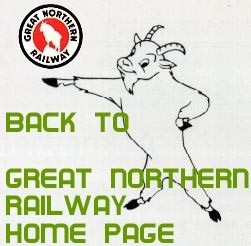|


| |
GN Electric Operations continued
5016 and 5017 must be run with other General Electrics in
multiple, keep newer General Electrics on head end for
best operation. In a pinch, run any combination necessary.
General Electric Units — Putting Into Regeneration From
Running
General Electric units may be put in regeneration in
two ways:
(1) Normally while train is running, i.e., as it breaks
over the grade and starts down hill. (2) From standstill
on a down grade.
(1) Normally, a General Electric unit is put into regeneration,
for example, at Berne, as train starts down hill
at its safe running speed (low for beginners).
(a) By gradually notching off speed controller to full
off.
(b) Then pull field or regeneration controller out to "E"
notch. That is as far as it will come.
(c) Notch out gradually on speed controller and watch
only the balancing voltmeter. Notch out until balancing
volts are about 400 or 500 on low, to right side.
(d) Then notch out gradually on field controller. This
will bring the balancing volts from 400—500 back to zero.
When balancing volts reach zero, the locomotive is
automatically in regeneration. Now watch D. C. field and
armature amperes. If field lever is notched out too fast, the
balancing voltmeter needle will come back to zero too
quickly and slack of train will come in hard. This is liable
to flashover motors.
The proper way is, bring the balancing voltmeter needle
back to about 50—100 low, from 500 low, then let train
speed drift your engine into regeneration, and by taking
one notch on speed lever just before needle of balancing
voltmeter hits zero, there will be no slack run in and
operation will be smooth. The ratio of field and armature D. C.
amperes must never be exceeded in motoring or regeneration;
otherwise motors and generators will be flashed over
on commutators and brush holders, causing heavy damage
or burnout. Ratio is maximum, 3 to 1. Good safe practice
is 2 to 1. Meaning, the D. C. armature must never even
instantaneously be greater than three times field amperes.
Examples, field 150, armature 450, or field 50, armature, 150,
field 200, armature 600. Never be abrupt. Smooth handling
comes from proper operation.
Page 37
General Electric Locomotives — Putting Into Regeneration
From Standstill on Grade
(2) Getting into regeneration from standstill on a down
grade where train will start itself, example; Berne, train
extra east stopped on grade:
Note: Swing helper may get into regeneration this way
also, but should not take load until entire train is moving
about five miles per hour, so as not to stretch slack
between helper and head end, slack must stay bunched.
(1) When ready to go, head end with engine-brake set,
pull field lever out to "E" notch, (2) take one notch on
speed lever, (3) pull field lever out so you will have about
400 amperes D. C. field, (4) leave speed lever on first notch
and release engine brake enough so engine will begin to
move, then pinch up engine brake so as to keep engine
back against train, until the train slack is all bunched and
engine is showing regeneration, on armature amperes 300
to 500 amperes, (5) then release engine brake and notch
out speed lever gradually. Do not let engine get motoring,
by too fast notching. Get up to running speed gradually.
When the locomotive is put into regeneration, then the
real job of controlling begins. Primarily, the train speed
must be controlled at certain defined limits. To do this
properly without jolting train or damaging electric
locomotives, requires that good judgment be used at all times
and that the limits of operating D. C. amperes, as well as
the ratio between D. C. field amperes and armature
amperes never be exceeded. Exceeding ampere limits or ratios
results in damaged motive power due to flattened wheels,
flashed over or burned out motors. Trains are easily torn
up by mishandling in regeneration. Remember, the power
station charts show every move made by all units on the
system, so all alibis are out. Hence, know your stuff and
apply it all the while on job and troubles will be few.
Regeneration is one operation where troubles are almost
unnecessary as ten years results show, so it is up to the man
individually to keep it that way.
Train Operation in Electrified Territory
Motor generator type electric locomotives are used in all
classes of service, except local freight and switching. There
are two designs of locomotives in service at present. The
General Electric mallet electric type, 2,500 K. W. capacity
is rated at 1,000 tons trailing load on 2.2% grade. The
Page 38
Westinghouse design is referred to as a Mikado electric of
1,500 K. W. capacity and rated at 750 tons trailing on 2.2%
grade.
The normal or continuous tractive effort of these
electric locomotives are: General Electric 61,000 lbs., and
Westinghouse 45,000 lbs., per cab. The cab weights are:
General Electric 260 tons. Westinghouse 180 tons. These
locomotives are so powered that they can exert a tractive
effort of two and a half times normal, up to slipping
drivers.
When two and three of such cabs are coupled and run
in multiple unit operation under control of one man, he
better be careful as with three cab engines being crowded
or notched up too fast, especially on head end of freight
trains, concentrated tractive efforts of 250,000 lbs., to
350,000 lbs., are possible. These forces must be gradually and
properly applied for the maximum degree of safety. Its a
case of using good judgment at all times.
Ordinarily, the heaviest tonnage trains can be started
on the 2.2% grade — three General Electric and three
Westinghouse cabs — with the following tractive efforts: three
General Electrics on head end using about 400 amperes
D. C. armature to 550 amperes D. C., develop 120,000 lbs.,
to 180,000 lbs., tractive effort, while three Westinghouse
cabs in swing helper using 4,000 to 5,000 ampere D. C.
armature, if necessary, will exert a tractive effort of 245,000
lbs., to 330,000 lbs. The helper engine must exert
maximum tractive effort possible up to the 4,000 — 5,000 ampere
limits, Westinghouse engines, and when General Electric
helpers are used in swing position, when necessary, they
should be worked up to 600 — 700 D. C. if no slipping
occurs. When D. C. amperes above the limits given are used,
kickouts of overloads, or crushed in cars may result.
SAFETY ALWAYS: Helper engineers and everyone
else keep away from end of cab that is pushing against
train. If cars should fold up you might get hurt.
Remember, it takes between a total of 315,000 lbs., to 323,000
lbs., tractive effort to keep a 5,250 ton train rolling on 2.2%
grade and to start, then accelerate up to ten miles per hour
on 2.2% grade in one minute requires a maximum tractive
effort of 425,000 lbs. Do not be in too big a hurry to get
going. The limits shown are merely limits nobody must
exceed under any conditions. Tonnage trains can be started
on lower D. C. amperes, and less tractive effort, and if it
takes five minutes to get up to ten miles per hour instead
of one minute, that is okay. Just be careful, especially
Page 39
head end. Do not pull over continuous D. C. amperes to
get started, and apply that gradually to get all slack
stretched, or you will snap off a draw bar. Good drawbars are
broken from two causes, mainly (1) too rapid application
of a moderate tractive effort, (2) too much tractive effort
regardless of how carefully applied. If 200 or 300 D. C.
will lift the slack, then be ready if necessary to quickly
drop a notch or two when the slack is all stretched, or the
amperes will run up to higher values as you stall. The brunt
of starting all trains must be on the helper engine. Hence,
helpers boost them up to wheel slipping point once you
get your starting signal, and head end use about continuous
D. C. after slack is stretched.
Starting Tonnage Freights
Be sure to wait long enough for air to release. When
road engineer knows train is ready to leave town, whistle off,
and notch out to stretch slack, then ease that slack back
against helper, who on feeling slack bump, will notch out
his engine and boost train. Head end will then proceed
to take and hold his share of train and try to keep
accelerating on just below if possible, but not exceeding
continuous D. C. amperes. Neither one of you can handle train
by yourselves, and by watching your meters and working
together, the tonnage trains will move okay. Should helper
be in trouble, and not ready to start when head end is
ready, nothing but slack will come when head end tries
to start, and if meters are watched (do not watch ground)
the starting break in twos will not occur. Then when
helper is ready, he will shove up the slack and head end proceed
to take your load. Both be careful. The lowest amperes
that will start a train are the best to use, but you must use
enough. Hence, helper crowd his engine and head end pull
normal load at maximum starting. This system has worked
okay here and elsewhere on heavy trains.
Running Tonnage Freight Trains in Motoring
After a train has been accelerated up to its running
speed, as limited by dispatched synchronous amperes, or
full synchronous amperes where no power limiting order is
received, full load synchronous amperes General Electric
is 1,350 amperes, and full load synchronous amperes
Westinghouse is 1,450 amperes.
When running speed is reached, the D. C. armature
amperes will settle back to continuous or less for lighter
trains, and ordinarily this value must not be exceeded by
Page 40
 
 
|